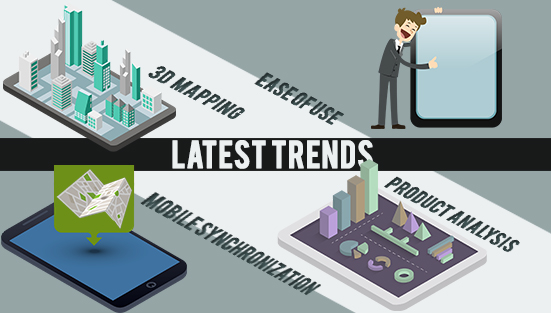Digital wayfinding kiosks and signage have been enhancing visitors' experience of years. The trend continues to be on the rise, and we can see why: these devices are being introduced in greater frequency within buildings and campuses, malls and venues, public spaces and residential communities, hotels and resorts, and other facilities.
With the purpose of providing an accurate location, intelligent paths, and easy-to-use interface, digital wayfinding is continuously improving to provide a better user experience. Media and tech companies are developing powerful software that uses cutting-edge technology to include features that fit the needs of every market and industry.
What features and trends can be predicted for 2016?
1. Enhanced Mapping Capabilities
Transforming a 2D map into a 3-dimensional map will be a great feature and a big sell for companies creating wayfinding software. That 3D "immersion experience” offers a virtual environment, to enhance a viewer's experience and induce a realistic sense of spatial awareness and familiarity.
2. Mobile Integration
Today's consumers are more reliant on their smartphones, tablets and personal devices. They want fast information -in their hands. With this demand, improved wayfinding software will become adaptable and integrated into consumer devices with increased prevalence. Formats taken can include: downloadable mobile apps physically installed sensors and wifi solutions which push limited information to the mobile device. As an example, a wayfinding company integrates their software into mobile applications that provide walking directions, maps, and location-specific content.
Foresight's include: delivering coupons when consumers are near the physical store they are looking for, apps that offer direction and other information when landmarks are approached, or suggested path corrections when users deviate off course. These technologies introduce avenues for the personalized experience that customers have come to expect, and will become more common due to high demand and value.
It is likely that mobile integration will dominate the market and will be the preferred method of access for viewers and consumers who seek information.
3. Consistency
Unity serves as the golden rule in wayfinding and interface design. Throughout the user experience, the wayfinding system has to remain consistent, as this will pay off in the eyes of the consumers.
A valuable wayfinding software feature is one that provides optimized communication through visual aesthetics. This can be seen in the entire software layout, navigation, font size of typography, branding standards chosen, etc. When everything remains consistent, the software is easier and more pleasing to use.
4. Enhanced Branding Efforts
Branding is an important component of wayfinding digital signage software. Through a stylized experience, businesses can unify their images, signs, and logos with information on digital kiosks or other IT systems to create greater impact and more engagement with the viewer's experience. This also allows individual companies to use their logos as a reference that will help consumers find what they are looking for; bringing the experience full circle, while reinforcing brand awareness and loyalty.
5. Dynamic Data Integrations
Another wayfinding feature that is becoming popular is the provision of additional elements to enhance the wayfinding information.
For instance, in convention venues, users can first use wayfinding kiosks to locate booths, shows, trade fairs, conferences, etc. in different halls. Next, additional information can be provided by pressing the "know more" button. This information can include details of the meeting, speaker bios, schedule, and a lot more. In some scenarios, videos or other media are coupled with the wayfinding feature.
As more data becomes available, a more comprehensive wayfinding kiosk experience is enabled for the viewer.
6. Performance Analytics
Today's interactive wayfinding technologies are incorporating data performance analytics to track kiosk usage. These features help businesses to learn how customers interact with digital touch points and what strategic insights are dictated by these behaviors. Insights such as favorite searches, product selections, and decisions made can lead to more personalized experiences for visitors.
While convenience remains a top priority for wayfinding kiosks, accessibility is of equal paramount. Gaining the insight of which particular locations are more often searched can help business owners add more signage to highly frequented areas.
For example, the data on a mall wayfinding kiosk reveals that the flower shop is being searched more than others. Knowing this, a business owner can create strategies to make their shop more visible and easier to find. Alternatively, choose to leverage the kiosk as advertising space to capitalize on measured traffic.
These wayfinding trends offer a better opportunity to serve more viewers, guests, visitors and consumers, which in turn results in a very desirable wayfinding experience; and thusly a lasting reputation for a comfortable visit.

